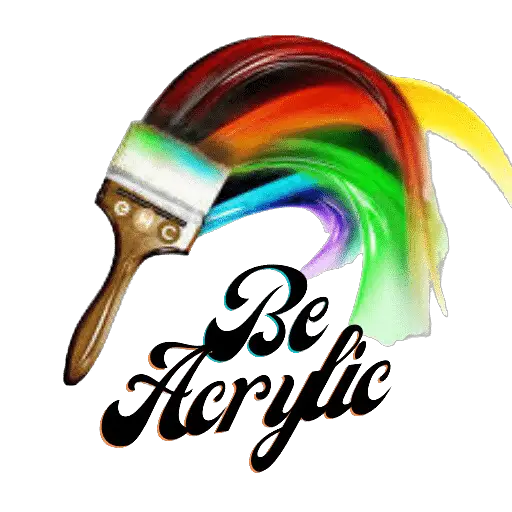Having a gorgeous acrylic manicure makes you confident. Acrylic liquid (monomer) protects your nails from cracks. Acrylic nails are false nails or enhancements that are long-lasting, would not break easily, and last 2-3 weeks with good care. It brings glamour to women’s life.
Acrylic nails need two components, Acrylic powder (a polymer) and a liquid (a monomer). The monomer reacts with the powder to create an extension that air dries and can last up to three weeks. Manicurists use this monomer with acrylic powder to make nails for their customers.
Ethyl methacrylate (EMA) is present in the acrylic liquid, which mixes with white powder to make an adhesive material that can be molded easily into any solid shape. If you’re out of the monomer, there are acrylic liquid substitutes you can go for.
Once, I used the no-monomer method by mixing ten scoops of clear acrylic powder and a neon pink color, and lastly, I added some shimmer from my eyeshade palate. Then I applied foil glue to my nails and directly poured the acrylic powder that I had just mixed directly onto the nails. The result was amazing!
In the blog post, I’ve discussed and argued ten legal acrylic liquid substitutes with their pros and cons.
What is acrylic liquid?
Acrylic liquid is chemically knowns as monomer. It is a liquid compound used to activate the acrylic powder in order to facilitate polymerization. It aids in enhancing the bonding and durability of acrylic nails.
Importance of liquid monomer:
- Acrylic powder is nothing without acrylic liquid.
- It gives strength to your nails.
- Purple tone monomer prevents acrylic from yellowing.
- Controls polymerization process.
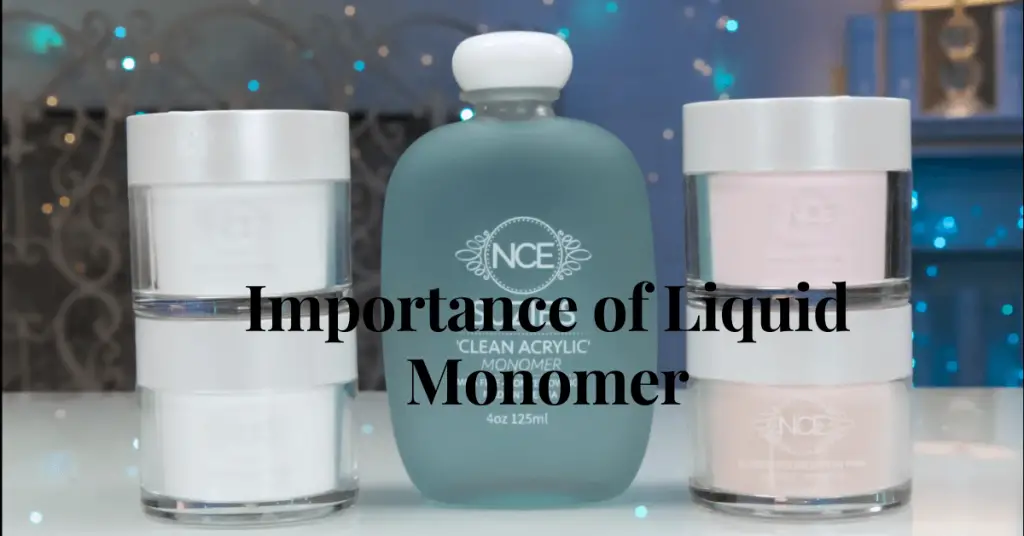
10 Legal and right acrylic nail liquid substitutes:
If you’re a nail technician or fond of doing acrylic nails at home, you may be wondering, “What can I use instead of acrylic liquid?” Well, there are a few alternatives to traditional acrylic liquid that you can consider. They are as follows.
1. Polyester resin on false nails
Polyester resin is liquid glue made up of Cyanoacrylate, which adds strength to natural nails. Salon-quality manicures can be achieved by using chemical-free polyester resin. Apply these resins before pouring acrylic powder onto your nails. Repeat this process 2-3 times until you get your desired color.
| Advantages | Disadvantages |
| Can be dissolved into acetone | It cannot be used to extend the nails |
| More glossy and natural looking | Leaves green hue o nails |
| No harsh chemicals | Always need an activator to get hardness |
The best and recommended polyester resin is Toluene fonamide formaldehyde. It improves adhesion and makes your nails glossy.
2. Hydrogen peroxide: An Environmental friendly substitute
Hydrogen peroxide is another legal alternative to acrylic monomer, and it is best because, like other chemicals, it does not remain in our environment for a long time.
For the flawless finishing of your nails, the proportion of hydrogen peroxide and fluid to the acrylic powder should be 1.5 to 1. To get rid of air bubbles, make sure you take an acrylic nail brush of good size to fill it with monomers.
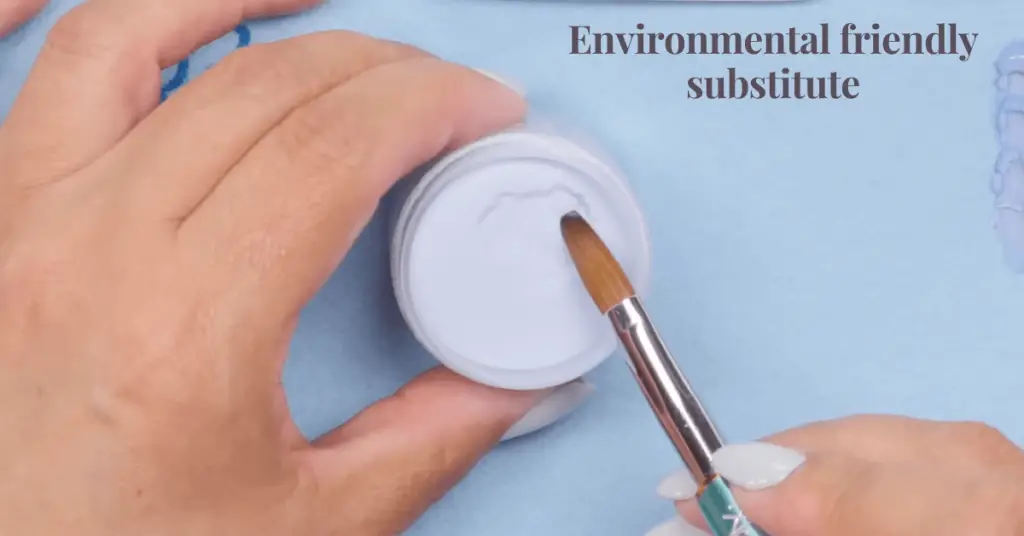
Hydrogen peroxide can dry your nails; it is recommended to use cuticle oil or any moisturizer after getting your nails done.
| Advantages | Disadvantages |
| Environmental friendly | Irritation at the site of contact |
| Destroys the fungus on your nails | Irritation to the respiratory throat and nose |
| Also, help to take off your acrylic nails at home | It may cause pulmonary edema |
Always purchase plate-less acrylics, which are also protected from UV light, and wear gloves while using hydrogen peroxide.
3. Homemade DIY: (No Monomer, No Activator)
French acrylic nails can be designed at home without using any monomer. Buff your nails and put foil glue as your DIY peel-off base. After the foil glue has dried, put a thick layer of base gel over the entire nail. Put your nails under a UV lamp to cure them for 30 to 40 seconds.
Now you are ready to apply your nail tip and buff them. Put a layer of base gel to strengthen the nails and cure this under a UV lamp for 45 seconds. Use acrylic powder from the best brand. Use base gel o buffed nails, take a powder, and pour over the foil glue while it is still wet. Allow to self-dry.
Take a duster brush to remove the excess dust. Now use mate top gel. Mate top gel works well with foil glue to add a second layer. Repeat the same process for the 2nd and 3rd final layers.
In the end, add glitter polish and rhinestones to your nails and cure them under a UV lamp for around 45 to 60 seconds.
| Advantages | Disadvantages |
| Need just non-toxic glue | Time-consuming |
| You don’t have to visit a salon | Poor quality of work |
| Affordable, simple, and easy to make | End up with something you don’t expect |
4. New ways to do the press-on technique
This technique is a game-changer and super easy to master. For this substitute, you need nail primer, a top coat (optional), clear all-in-one powder, 100% acrylic press-on nails, and an acrylic brush.
- Start with sanitized hands.
- Use a cuticle pusher to push back the cuticles.
- Apply a thin layer of acrylic primer to the natural nail.
- Pick a small bead of acrylic and place it on the underside of the nail tip.
- Take the tip and place it on the natural nail at a 45-degree angle.
- Slowly press it down to avoid any air bubbles and hold for 10 seconds.
- Add a layer of gel top coat (optional step).
- It is all about having a perfect and thin acrylic manicure that will last three weeks and take only a few minutes to apply.
| Advantages | Disadvantages |
| Easy to remove | Not durable |
| Reusable | Can be infectious |
| Affordable and easy to maintain | To avoid infection, you put them only for 2-3 days |
| No harsh chemicals | Sensitive in exposing harsh conditions |
| No complex method to apply | It can damage your cuticles |
5. Dip powder fills for nails
Dip powder is the new art of manicure systems which is also a substitute for acrylic liquids. Dip powder activators are in the form of a gel. Dip powders are super pigmented. The essentials in this technique are bonds. Base, seal-protect, top coat, and nourishing oil, powder, and your recycling system.
- Push back the cuticles and get rid of all the lifted areas to avoid bulky nails.
- Dehydrate and prime the nail.
- Apply a thin layer of base and dip it into the powder at a 45-degree angle.
- Dust the excess powder away to avoid contamination of the base.
- Apply another layer of base and again dip it into the powder, and dust off the excess powder.
- Encapsulate your fresh nails with a recycling system, which helps to keep powder as clear as it can be.
- Apply the base and pour the clear powder over the top and remove all the excess powder.
- Seal the powder by applying for soap protection and letting it dry.
- The next step is filing, shaping, and buffing when it is dry.
- The super important step is to rub the nail and remove the extra dust by using wipes.
- Apply the first layer of the shiny top coat and allow it to dry.
- The second layer makes your nails shiny. Apply another layer and allow it to dry completely.
- It is all about having a quick and easy dip powder fill. Enjoy the beautiful shape in no time.
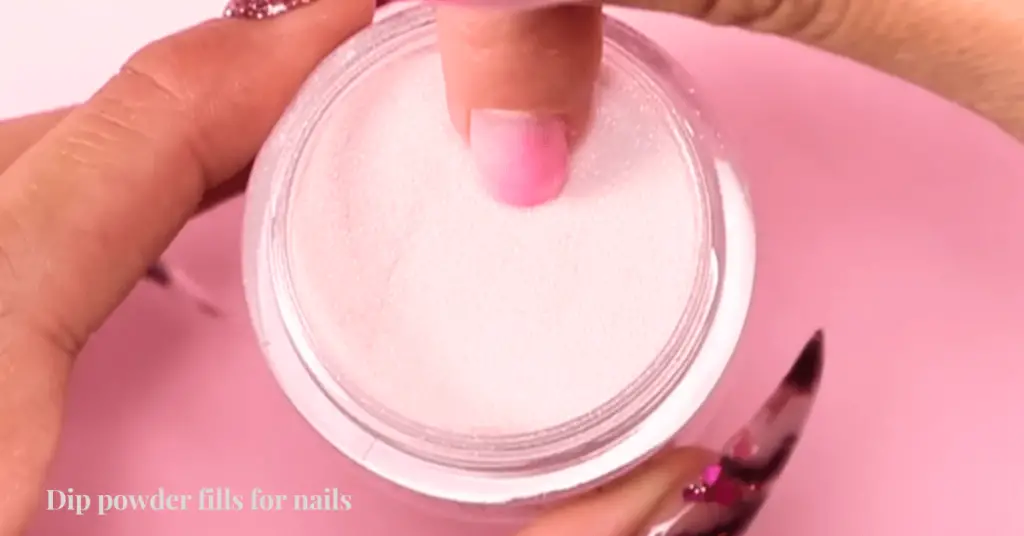
| Advantage | Disadvantage |
| Long-lasting | Expensive |
| No harsh chemicals | Sometimes unhygienic |
| Easy to apply | So heavy and tough |
| Don’t require a UV lamp | Not easily removed |
Recommended dip powder is Kiara Sky’s New Pedi Pack and Color Dip Powder Starter Kit.
6. Gel polish for velvet mate
There are a few tricks and tips to get perfect velvety nails. Apply the first coat of gel. For the flawless mate, it is important to cure them for 60 seconds before going towards the second layer. Shake the Velva mount.
Apply it on the entire nail and the sidewalls to get a flawless velvety look. When the nails are fully covered, cure them under a UV lamp for 60 seconds.
The final look is smooth and super velvety no sticky residue left on the nails.
| Advantages | Disadvantages |
| Long-lasting and very resistant | Less durable than acrylics |
| Not expensive | Very hard to remove |
| Easy to apply | UV light exposure |
| Quickly dry | Need more work |
| Looks like natural and velvety nails | Less variety of colors |
Recommended gel nail polishes are Olive and June Nail Polish, Chanel Le Gel Coat Long Wear Top Coat, Dior Vernis Gel Shine, and OPI Gel Color Nail Polish.
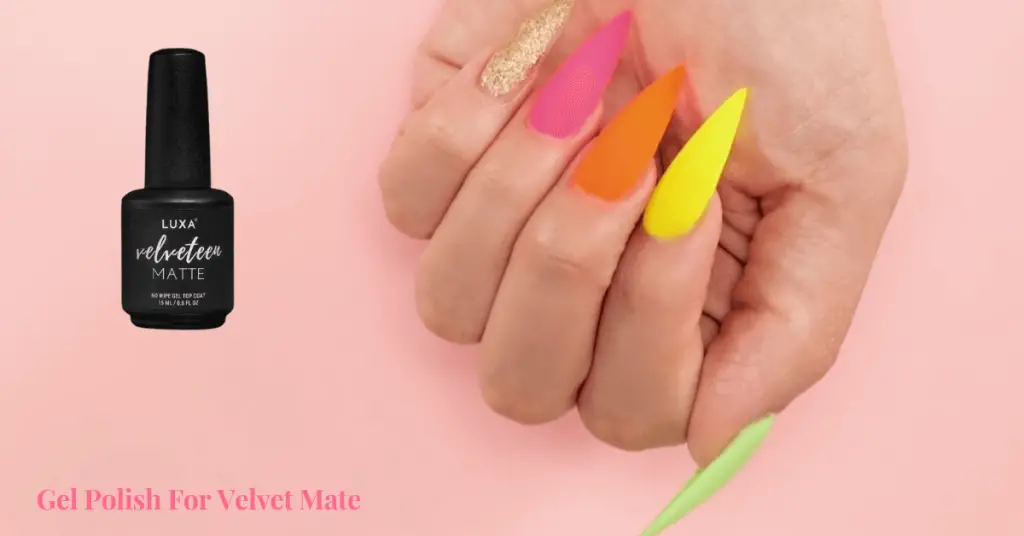
7. Using rubbing alcohol as a monomer
To achieve an easy manicure rubbing alcohol is another alternative to acrylic monomer. I used simple tap water as a monomer to pick a bead, but I failed.
Then I added rubbing alcohol to water to make my monomer. The result was good. To make a French look nail pick up the bead with alcohol monomer.
Alcohol sticks when your nail dries completely. To get finished nails, add a little bit of cuticle oil. The result is pretty cool.
| Advantages | Disadvantages |
| Evaporate quickly to get a quick manicure | It can easily penetrate the skin |
| Cost efficient | Drying out the nails |
| Antiseptic properties | Peeling and cracking the nails and cuticles |
Rubbing alcohol of 99% alcohol is recommended. SOLIMO 99% isopropyl alcohol is the best brand available at Amazon.
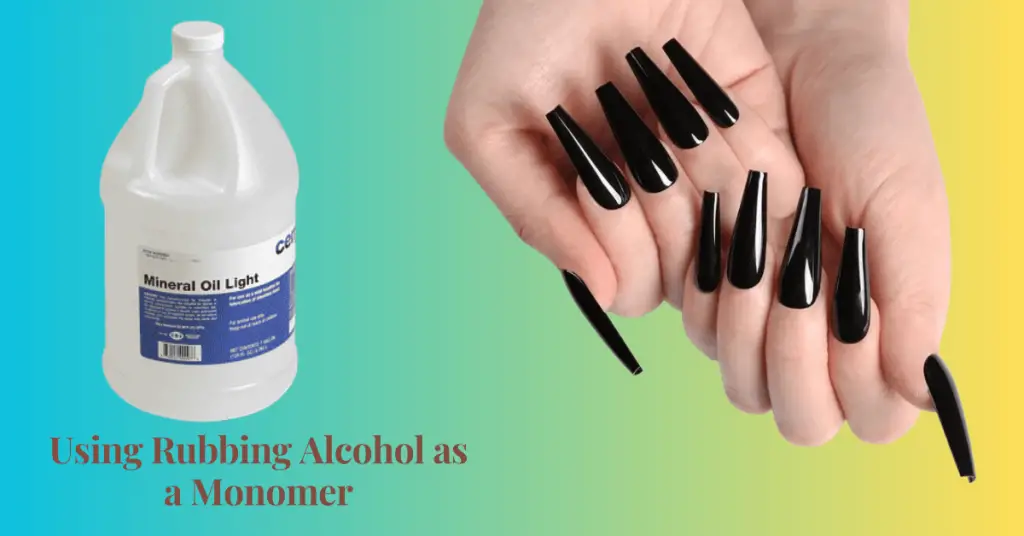
8. Nail art with stickers and water decals
Some accessories are available for your nail art without using liquid monomers. These are nail stickers and water decals.
Peel off the stickers and directly put them onto your nails. Choose any 3d sticker or water decal of your choice.
Put some foil glue on the nail and cure it under a UV lamp, and put the straight-edge sticker on the top. Use a lint-free wipe and rub it longer to make it smooth.
So don’t invest too much in salons, and go for the best quality stickers and enjoy good nail art as well as substitute for acrylic liquid at home.
| Advantages | Disadvantages |
| Nail protection from damage | Remain constrained |
| Quick manicure | Less availability in salons |
| Looks professional | Boring and unpopular |
| Clear and bright appearance | Allergic |
| No chemicals, normal coating | Not durable |
Recommended nail sticker brands are Scratch Nail Wraps Kit and TailaiMei Glitter Nail Wraps.
9. Acrylic nail hack with Nail Glue
Nail glue is another replacement for acrylic monomer. Nail glue is thick and acts as an adhesive material. Another no-monomer method is using acrylic powder with nail glue instead of foil glue. It only works with plastic nail tips. Pour the acrylic powder over the wet nail glue.
Nail glue dries relatively quickly. If you are using this hack, be careful because it is painful when it touches the skin. Its finishing might be patchy, so it is better to file them. Put some gel polish and cure them under a UV lamp. In the end, the top coat is necessary.
Kudos to this hack; it works best.
| Advantages | Disadvantages |
| No damage to natural nails | Fall off easily |
| It can be pressed again | Bulky and less natural look |
| Easy to remove | Less durability |
Recommended best nail glues for home manicures are KDS Nail Glue, Cala Super Nail Glue, NYK1 Nail Glue, and Young Nails Brush-On Glue.
10. Solar Nails
Artificial nails are usually clear or pink in color are solar nails. Solar nails are healthy. They are made up of acrylic and gel. They can last six weeks with good care. UV light treatment is not needed. These nails are my favorite alternative because they are better for my health.
| Advantages | Disadvantages |
| Natural enhancement of nail | Visibility of nail growth |
| No discolouration | Use of chemicals |
| Remove easily | Thicker and heavier on hands |
The best solar nail designs are Glitter Solar Nail-Ombre Inspired Design and Natural Nail Art-French Manicure are recommended.
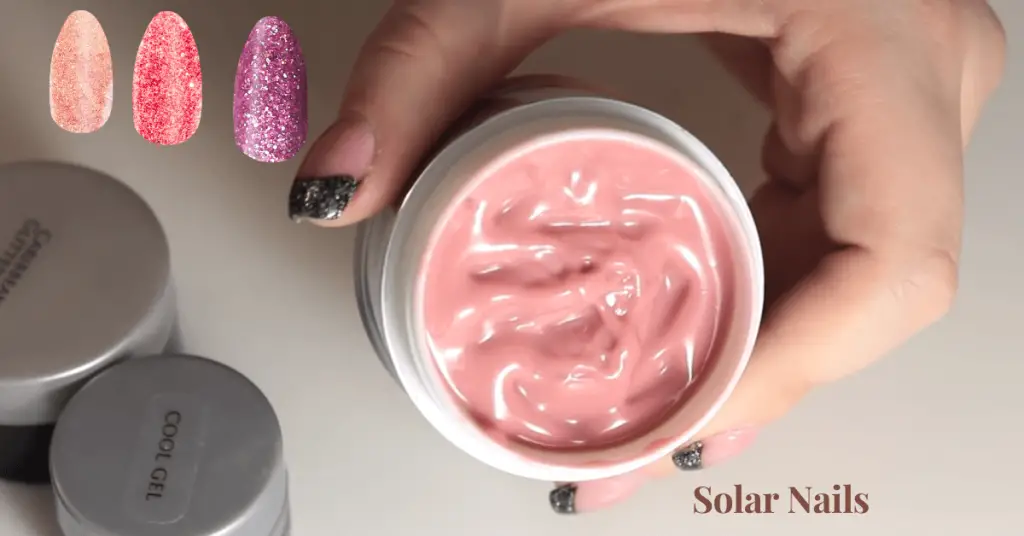
FAQs
What can you substitute for acrylic liquid?
If you’re looking for a substitute for acrylic liquid in nail art, there are some good options available. One choice is a gel-based system, which involves using a gel base coat and a gel top coat instead of liquid and powder. Another option is to use a poly gel system, which is a hybrid of gel and acrylic that doesn’t require liquid. You can also opt for dip powder, which involves dipping your nails into a colored powder and then sealing it with a top coat.
Is the fibreglass technique used as a substitute?
Yes, if you have a habit of biting your nails and have so much brittle and rough nails, then you will like the fibreglass technique. It makes your nails thick and healthy. This process is time-consuming but productive.
What are the best substitutes which harden your acrylic nails?
Dip powders are gel-like materials and are knowns as the best hardener for acrylic nails. It provides toughness to your nails. They are long-lasting and have no harsh chemicals.
The best dip powders are Kiara Sky’s New Pedi Pack and Color Dip Powder Starter Kit.
What is the difference between acrylic monomer and acrylic activator?
Acrylic monomers are used to mix with powders to create spongy consistency for your acrylic nails. On the other hand, an acrylic activator is a liquid used to cure and seal the powder, give hardness, and prep your nails for the last top coat. The best acrylic activator is Nail Gel Activator Spray 1 oz.
What to use as acrylic liquid?
Acrylic liquid is normally used in combination with acrylic powder to produce acrylic nail enhancements. The most commonly used acrylic liquid is a substance called ethyl methacrylate (EMA), which is specifically formulated for use in nail products.
Why do we need an acrylic monomer substitute?
Sometimes you may run out of your liquid monomer then you are in search of easily available substitutes. You might not want to invest in inexpensive salons to do DIYs at home. It might be possible that your nails are sensitive to chemicals in acrylic monomers. Search chemical-free alternatives.
What is the difference between solar nails and acrylic nails?
Strong acrylic nails are composed of acrylic monomer and acrylic powder. Solar nails are usually clear or pink in color; artificial nails can easily get at home. They are composed of putty-like substances. If you are looking for softer and more natural-looking nails, you should go for solar nails. But if you want durable and strong nails for a longer time, get an acrylic manicure at the best salon. It is just a matter of your personal preference.
Final Conclusion On Acrylic Liquid Substitute
Everything we use as a substitute for acrylic nails has pros and cons. Excess of everything is not good. Acrylic manicure is so fancy for you but is still bad for your health.
Substitutes are better than acrylics and safe for health. They are easy to make, convenient, long-lasting, beautiful, and cost-efficient.
In manicure treatment, gel-nail extension, dip powder, rubbing alcohol, and hydrogen peroxide. Poly gel false nails and nail wraps are the best substitutes currently.
I hope you found the post informative. Please comment for queries. Thank you for reading!
- How To Buff Acrylic Enamel Paint In 5 Easy Steps? - February 2, 2024
- How To Make Acrylic Paint More Opaque? 10 Effective Methods - February 1, 2024
- How To Sketch On Canvas Before Acrylic Painting? Draw Like a Pro - January 31, 2024
